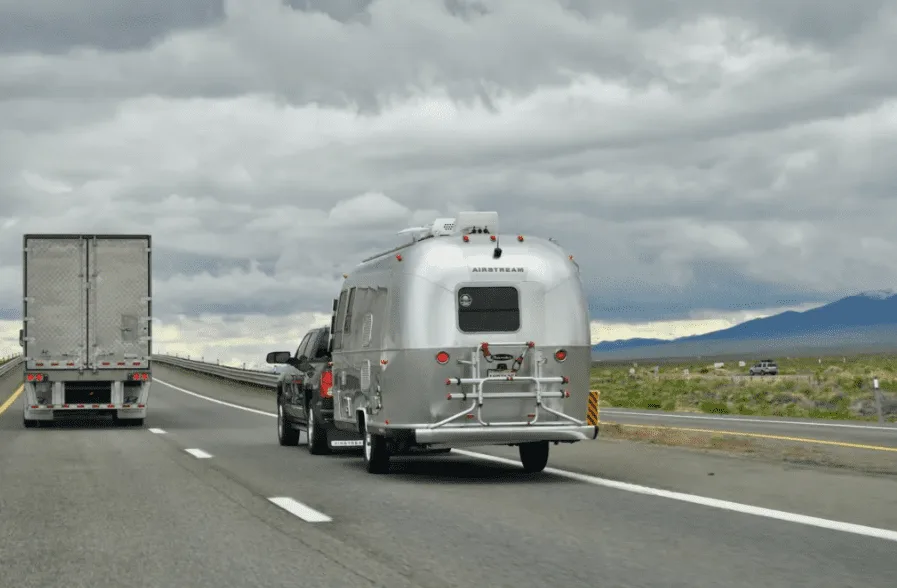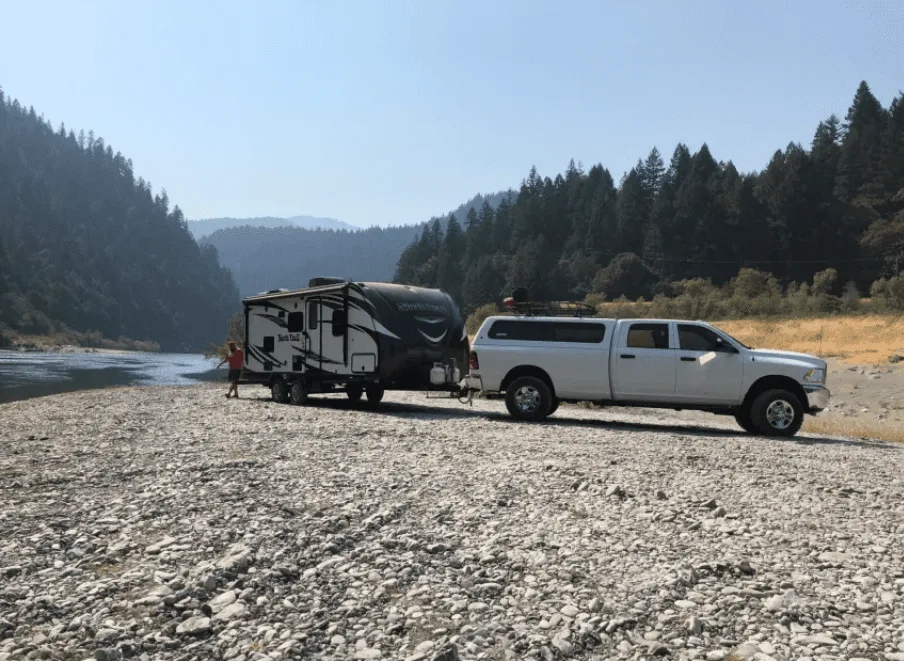You’re probably damaging your trailer if you’ve been hauling it without a sway bar. This crucial piece of safety equipment serves an essential purpose.
While not everyone uses one, when we found out what they were for, we rushed to get one installed. So what is a sway bar, and what happens if you don’t use one?
Today we’ll discuss the physics of highway driving and what you can do to protect yourself.
Let’s hit the road!
What is Trailer Sway?
Trailer sway, or fishtailing, describes the side-to-side motion that happens when hauling an RV. It most often occurs on vehicles that use a hitch well behind the rear axle.
You may have driven a high-profile vehicle on a windy day and felt away. But anything you pull can also have a similar rocking motion, and it doesn’t have to be on a blustery day. It’s also a warning sign that something’s not right. If you don’t pull over to address it, you’re putting everyone around you at risk.
Uncontrolled movement can make it difficult to control your vehicle. You’ll need to make a lot of steering adjustments to avoid an accident. In some cases, your camper may flip if it gets out of hand.

What Causes Trailer Sway?
If you notice trailer sway while driving, it can have several causes. One of the most common is speeding, which has a simple solution. But other situations require a little investigation. Sometimes, you can pull over and fix it, but other times you may need to wait out the weather or find a different route.
Wind Gusts
The wind is one of the biggest culprits for trailer sway. And on especially windy days, traveling on the highway only worsens it.
Because campers are so large, they have a lot of surface area to catch drafts. So while you may be fine in a sedan, pulling your motorhome makes you incredibly vulnerable. Sometimes wind from other large vehicles on the road can rock what you’re towing.
This is a factor that’s beyond your control. So check the weather before you head out, and try to avoid traveling during days with a strong breeze. And when you’re on the road, beware of passing trucks and RVs, and always drive with both hands on the wheel to maintain control.
Uneven Weight Distribution
Loading your camper for travel days will require a little math. When you put too much weight on one side, your RV may sway as you drive. It can be especially rough when you’re making turns.
Ideally, you should put about 60% of the load in the front, closer to the hitch, and the rest in the rear. But you always want to make sure it’s evenly distributed on either side of the trailer. And whatever you do, don’t overload your vehicle.
Pro Tip: Need help with weight distributing? Learn more about What is a Weight Distribution Hitch for Camper Trailers?
Rough Roads
While your truck may be able to handle bumpy roads, rough roads can create trailer issues. Most towable campers don’t have the same high-quality suspension. The more they bounce, the more likely they may twist or slide towards your hitch.
Investing in a sway bar is worth it if you plan on driving off the grid. Rough roads can also unbalance your load if it’s not adequately secured. When you encounter bumpy or gravel conditions, take it slow and don’t make any sudden turns.

What are RV Sway Bars?
RV sway bars are installed on vehicles or trailers to stiffen movement and minimize side-to-side motions. These simple devices come in two main types.
One type is designed to attach to your hitch to reduce rocking. These look like two metal arms that connect directly to the towed vehicle. You can also add chains or adjustable rails for a little more control.
Camper sway bars are less common. They come as a single metal pole that installs between the tongue of the camper and the hitch. It helps maintain a steady distance between your vehicle and your load.
Are RV Sway Bars Necessary?
Whether or not you need a sway bar for your trailer depends on the type. Most standard loads don’t require one. But they’re a worthwhile investment for high-profile, lightweight campers.
However, fifth-wheel campers are much more stable. They attach over the axle and are much less susceptible to fishtailing.
If you plan on hauling your RV into remote areas or want more peace of mind, we highly recommend investing in motion control. They’ll give you more control on the road and provide a comfortable driving experience.
But they’re not a perfect solution. You still may have to deal with rocking if you’re driving too quickly or the wind is too strong.
Here’s the price of RV Sway Bars on Amazon.

What’s the Difference Between RV Sway Bars and Weight Distribution Hitches?
The main difference is their purpose. Weight distribution hitches help even out the load on your hitch. They also keep the trailer level with the tongue from front to back. Sway bars are for reducing back-and-forth motion. When you install both, they work together for a much more stable and safe ride.
Weight distribution hitches generally attach with chains or rails and can help improve maneuverability. Meanwhile, sway control systems typically have solid steel or metal beams. That means backing up is next to impossible because the camper won’t pivot when you’re in reverse.
What Should You Do When You Experience Sway?
Even with all the proper safety equipment, you should prepare to experience trailer sway. When it happens, there are a few things to keep in mind.
First, use slow and steady steering wheel movements to keep your vehicle straight. Counter maneuvers will only make things worse. If you have an auxiliary brake system, use it to help slow you down. Don’t apply your towing vehicle’s brakes. Take your foot off the accelerator instead.
You can install an electronic tow control monitor to automatically apply the brakes when you’re fishtailing.
But the best bet is prevention. Keep your speed at 60 mph or below, and avoid driving when the weather’s terrible.
Pro Tip: If you’re new to RVing, make sure you know these 11 Excellent RV Towing Tips for Beginners.
Stay Safe and Use RV Sway Bars When Towing
Don’t make the same mistakes we did as rookies. Installing a sway bar and weigh distribution system can go a long way to prevent an out-of-control trailer. Even better, safety systems for your breaks can prevent an accident when dealing with an unwieldy motorhome.
Hauling a camper has a steep learning curve. Make sure you get some practice in before you set out on your first big trip.
We’ll Help You Find the Best Free Camping in the USA
You should give it a try!
As a matter of fact, these free campsites are yours to enjoy. Every time you pay federal taxes, you’re contributing to these lands.
Become a FREE CAMPING INSIDER and join the 100,000 campers who love to score the best site!
We’ll send you the 50 Best Free Campsites in the USA (one per state). Access the list by submitting your email below: